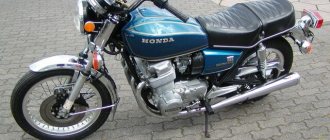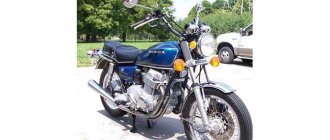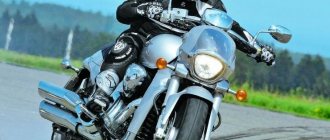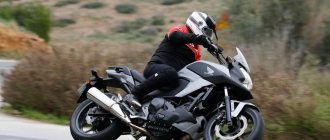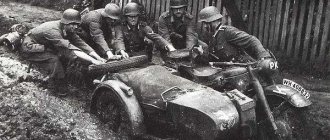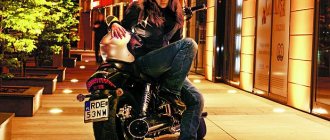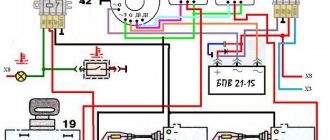Do you like automatic motorcycles? You're in luck because there are more and more of them. See how the Vario transmission (Aprilia NA 850 Mana) and the dual-clutch automatic transmission (Honda NC 700 S DCT) turned out.
Motorcycles with automatic transmission
Automatic transmissions today are not bad. On the other hand, motorcyclists treat them, at best, with barely concealed distrust, or, in the worst case, they reject them outright, saying “Are you crazy?!”
Honda believes that such motorcycles will become popular, so in addition to the VFR 1200 and Crosstourer, a dual-clutch automatic transmission is included in motorcycles from the lower price range: NC 700 S and NC 700 X. A complex combination at first glance, inexpensive equipment + expensive dual clutch , also debuted in the Integra scooter. It has the same engine as the NC, almost the same frame and a dual clutch interacting with a classic transmission.
The display includes: fuel level indicator, tachometer, clock, total mileage counter and daily mileage.
A space was found on the left side of the steering wheel for the parking brake lever.
On the right is the driving mode switch (gray SDN key).
The lower clamp at the rear is responsible for the parking brake. Wave brake discs.
001_MOTO_1010_018
Honda VFR1200F Auto: sports tourer, 2010, 1273 cm³, 172 hp, 790,000 rub.
Honda VFR1200F Auto: sports tourer, 2010, 1273 cm³, 172 hp, 790,000 rub.
FIRST PANCAKE. Honda has been and remains the main enthusiast for the introduction of automatic transmissions into motorcycles. Moreover, if you delve a little deeper into history, it will become clear that the sensational DN-01 is far from the first experiment of “winged” aircraft in this field. Honda has always pursued a rather aggressive policy of expansion into the North American market, and now the United States is one of the main consumers of large motorcycles of this brand. But, given this nation's selfless love for automatic transmissions on cars, not trying to introduce them to motorcycles would be, at least, not far-sighted. So, back in 1975, Canadians, and a year later Americans, had the opportunity to buy a real production motorcycle with an “automatic transmission” - the Honda CB 750 Automatic. I put quotation marks for a reason. In fact, that gearbox was a semi-automatic with a fluid coupling and mechanical shifting of two gears. That is, in essence, the pilot was spared the need to pull the clutch lever, but he still had to click the paw. The device turned out to be very thoughtful, gluttonous and not at all fast, even compared to its mechanical clone, and did not gain much popularity, even among Americans who are not very demanding of dynamics and controllability. Three years later, production was curtailed. Honda's subsequent experiments in this field also ended in vain.
Honda CB 750 Automatic
Honda CB 750 Automatic
DEAD BRANCH. Another serious attempt to get rid of the lever and claw can be considered the recent experiment with DN-01. Honda's proprietary hydrostatics, which have proven themselves so well on quads, generally felt good on the neo-chopperoid (geometry, landing, engine - everything is purely chopper, only in plastic), but this unit was worth installing on something more “evil” just dangerous - too thoughtful. Strictly speaking, the experiment with DN-01 can be considered the end of the experiment begun in 1975. Only if then these were the first attempts in the series “what will happen if ...”, then DN became the big blue seal of the registry office in the certificate of divorce between motorcycle and hydromechanics. What's next? So, hydromechanics is no longer needed. Variable speed drive? We passed too. There's also "robot" - the latest fad in car transmissions. Cheap and cheerful: I attached a couple of motors to the usual “mechanics”, the “brain” and off we go! Only these boxes are switched at about the speed of a housewife during her first driving lesson. Remember the instructor at the driving school: “you pressed the clutch, engaged the gear, then slowly release the clutch...” In general, this is also not an option. Of the “viable” options, only one remains - Double clutch transmission, a robotic gearbox with two clutches, also known as preselective. The relative simplicity and compactness of the design, lightning-fast switching speed, smooth operation, all this has long won the hearts of automakers. Audi, VW, Mitsubishi, BMW, even Porsche have been installing similar units on their cars for a long time, and not only and not so much on household “string bags on wheels”, but on quite serious models like Carrera 4 or Lancer Evo X, and this says About many things. This is exactly the transmission that the new VFR1200F sports tourer has received. We already wrote about the details of the box design in “Moto” No. 6–2009. I won’t repeat the description of the motorcycle itself—it’s covered in detail in the February issue of this year—but I’ll focus on the most interesting thing: how it rides.
The journalistic cliché “the first thing I do is get comfortable behind the wheel...” has a very practical meaning in the case of the “vyfer”. You won't be able to figure out the controls right away. I grab the steering wheel, the fingers of my left hand clutch at the air: there is no lever! It looks somehow wild and uncomfortable, well, you’ll have to get used to it. Now the buttons. On the right remote control there is the main selector of the box, a “rocker” with the letters “D/S” and “N”. Familiar from cars: “D” is Drive, “S” is Sport, “N” is neutral, respectively. Under the index finger there is another unusual “trigger” marked “AT-MT”. Clearly, this is a choice of automatic or manual modes, only the left leg falls into the air following the toes. There is no classic “foot” here either, and the box is controlled manually using “petals” on the left remote control. Under the index finger - “up”; under the thumb - “down”. Due to the fact that the space under the “trigger” of the high beam flasher is occupied by the “petal” of the gearbox, the light switch is made three-position: “far-near-far”, only the second “high beam” is not fixed in the pressed position - that’s the blinker. Another unusual device on the steering wheel is a cleverly shaped squiggle that seems to go around the steering wheel at the left console. It may sound funny, but it's a parking brake. The last time I saw a handbrake on a motorcycle was on products from the Irbit plant, but those were for wheelchair users. But here everything is logical. A motorcycle with an automatic transmission cannot be left in gear if you suddenly have to park on a slope. And so he pulled and went. The main thing is not to forget to “take off the handbrake” later. Apart from the warning light on the dashboard, nothing indicates that it is on (only the motorcycle accelerates a little slowly). The system itself is quite simple. An additional cable-actuated caliper is installed on the rear brake disc. The lever on the steering wheel is connected to it. Let me note that after the test, I mechanically looked for this lever on other motorcycles for a couple of weeks. It’s very convenient, when you stop at a traffic light downhill, you don’t have to hold the device with your feet or the brake, but just pull the handle.
After a short introductory course in control systems, I hit the road. Or rather, I got ready. Because it was the moment of starting off that worried me, perhaps, most of all. How will the 1200 cc monster react to the movement of the throttle? Will it move? Or will it stall like a scooter until the clutch engages, and then it will still pull? Or, on the contrary, will you have to wait two seconds until the electronics deign to figure it out? Indeed, in traffic jams, in heavy traffic, and even just on the highway, a quick reaction can be a big help, and the reaction of not only the pilot, but also the motorcycle. To my great pleasure, my fears were not justified. The “magic engineers” from Honda tuned this controllability parameter so delicately that I had no choice but to sprinkle ashes on my head for mistrust and skepticism. The motorcycle starts moving from the first degrees of turning the handle, and the dependence of the engine thrust on the angle of rotation of the handle is absolutely linear. Do I need to go two centimeters? Please. Need five? No problem. Do you need to pull forward from under the “driver” who cannot slow down? No questions asked either. And making your way between cars stuck in traffic jams with such a reaction to the gas is a pleasure. Easier than riding a fifty-kopeck scooter.
But whatever one may say, the “automation” is still a little late - the start is sluggish. With the first centimeters of movement, the engine delivers only a small part of its torque, even if you twist the throttle all the way. For about a couple of seconds, the motorcycle openly “stalls”, apparently waiting for the clutch discs to fully close, in order to avoid their excessive slipping, and only from about 2000 rpm does it “shoot” at full force. On the one hand, this moment was incredibly annoying, because from the traffic light everything, even half as powerful and cubic-sized vehicles, easily went into a gap of a good couple of tens of meters, while the smart guts of the “vyfer” were tinkering with the clutch. On the other hand, this “caution” allows you to not be at all afraid of the frantic torque of the engine. Right from the spot you open a “full hole” and simply go to the point, albeit with a short “plug” at the start. No slipping, no attempts to turn up the nose (and this is at 172 hp!) or “deviate” from the intended trajectory! Obviously, this is also due to the 190th cylinder, which provides a “hold” with a huge margin. The only “but” is that all this automation does not allow “goating” at all. No matter how you twist the handle, the motorcycle will firmly hold onto the asphalt with both wheels. Well, this is not some kind of “fireblade”; it’s not appropriate for such a serious device to “jump its legs.”
Tuning
The Honda CRX is still popular among tuners around the world, and this is evident because the engineers initially designed a sporty, reliable, rigid coupe. Cars undergo both deep internal tuning and external styling. Many owners make swap (link to article about swap) for B series, for K series. Many people install turbines. What is noteworthy is that the Mugen tuning studio has released its signature turbo kit:
Turbo kit from Mugen
The famous tuning studio Mugen did not limit itself to producing turbines; it produced many components for the Honda CRX.
components from Mugen for Honda CRX
Test drive, swap K series.
010_MOTO_1010_018
...and the presence of a second (parking) caliper on the rear brake disc.
...and the presence of a second (parking) caliper on the rear brake disc.
So, let's go. Smoothly, sedately, unhurriedly. The box is in Drive mode. You can hear how, under the gas tank, the automation lives its own life, clanging rather loudly with pieces of iron. At the same time, no jerks or “pecks” are felt when switching. There is practically no interruption in the power flow. In any case, my brain is not able to track it. The motorcycle just accelerates. The speed is about 70 km/h, and the selected gear indicator shows the number “6”. The tachometer shows less than 2000 rpm! In the “drive” mode, the “drive” is occupied with only one thing - it saves fuel. Probably, if it had been his will, he would have turned off the engine altogether and suggested that the pilot move on muscle power. In city mode, the engine does not raise the speed above 2500 at all, and from the start, with smooth acceleration at half a gear, it generally skips third and fourth gears, switching directly from second to fifth. Of course, in this mode, talking about dynamics is inappropriate. The motorcycle simply sluggishly moves the rider from point A to point B. Of course, the system also provides a “kick-down” mode, when, with a sharp and full opening of the gas, the automatic machine “understands” that it is required to accelerate as much as possible, and drops it to fourth, but this happens with a delay of about half a second. In fact, this driving mode will be appropriate in the main element of the “drive” - on the highway, where “shots” from traffic lights, sharp accelerations in traffic and other fuss are not needed.
At the next traffic light I switch to “Sport” mode. Of course, I expected that the automatic would not skimp on speed, but not this much! The sport mode was apparently set up by comrades from the company's racing division, because the electronics do not shift up until the tachometer needle touches the red zone. On the one hand, it is clear that the motorcycle operates in the most efficient mode in terms of dynamics, but, excuse me, this is “two hundred liters”! In a matter of seconds, the motorcycle gains slightly over a hundred, and you want to tuck in a third, or even a fourth, but the stubborn automatic continues to squeal in the second, near the red zone, with the gas almost completely closed. It's annoying, even if you use your hands. On sports cars, this ultimate mode of operation of the box is usually called the letter “R”, that is, “Race” is a race, but “sport” should still be more “civilian”. In a word, in terms of the nature of its operation, the VFR automatic machine is somehow very youthfully maximalist. Either we spend all our money, or we sleep. What is really missing is that very intermediate algorithm than “drive” and less fanatical than “sport”. The “self-learning” nature of the machine would be very useful here. I drove it in manual mode for about fifteen minutes, and it already roughly “understood” what you wanted from it... But no, you have to be content with what you have, sometimes helping the machine with your hands.
By the way, driving in manual mode is a special pleasure! Just the ability to switch at full throttle is worth it! A box with two clutches allows this. Moreover, releasing the gas before switching does not lead to anything other than an unpleasant nose dive and the loss of a few tenths of a second during acceleration, so it is even advisable to switch “on gas”. This is the “built-in quickshifter”. Of course, shifting without interrupting the flow of power makes possible and even commonplace such a mechanical-motorcycle “taboo” as changing gears in a turn. Even “on the knee”! In general, those who like “full control over the motorcycle” will like the manual mode, but I, a pathological lazy person, got tired of this “toy” very quickly. Why bother when you can just turn the handle? Perhaps in moments of particular stubbornness of the machine, when it does not want to push the increased one, you can help a little, but no more.
After a week-long test of “auto-shift”, I can safely say that Honda has made a real breakthrough in the field of “automation” of a motorcycle. In terms of hardware, the machine is worthy only of excellent ratings! Smoothness and speed of switching, clarity of operation, clarity of its operation to the pilot... in general, not a single complaint. But in the electronic part, in my opinion, there is something to work on. The switching algorithms are far from ideal; the box “brains” clearly lack learning ability and, in general, sensitivity to the pilot’s commands. If even the most “oaky” box of some American family station wagon from the mid-eighties “understands” that when accelerating, when releasing the gas, you need to switch to a higher gear, why doesn’t a product of the 21st century understand this? Although, reconfiguring the “brains” of a well-functioning unit is a simple matter, and I think that Honda itself will soon offer new firmware versions, and alternative manufacturers will not miss the opportunity to cut off a “piece of the pie.” I bet that very soon similar units will appear on motorcycles from most leading motorcycle manufacturers, and motorcycle tuning catalogs will be replete with alternative transmission control units for every taste. In short, Honda has opened a new page in the history of the motorcycle, and let the snobs who grumble about the purity of style and the unacceptability of all sorts of “electronic crutches” like ABS, stabilization systems and automatic transmissions continue to ride twenty-year-old “dinosaurs”, but I am for technical progress. And, you'll see, in just a few years, automatic motorcycles will become as commonplace as a mobile phone is now. I put down a bottle of whiskey.
Honda NC 700 DCT or Aprilia Mana?
The Aprilia was better in terms of driving pleasure and comfort. However, the more refined powertrain, lower running costs and fuel economy favor the Honda.
In our opinion
1. Honda NC 700 S DCT. High gear shift speed and response to load changes. Box modes sometimes fail. The equipment is just for lovers of technical gadgets.
2. APRILIA 850 Mana ABS. If you need a motorcycle for a more comfortable ride, check out this one. Sufficient power and a precisely tuned gearbox combine the advantages of a motorcycle and a scooter in an almost exemplary manner.
Post Views: 7,979
015_MOTO_1010_018
Anyone who has ever driven a car with an automatic transmission will find a common language with this motorcycle in a couple of minutes!
Anyone who has ever driven a car with an automatic transmission will find a common language with this motorcycle in a couple of minutes!
Technical characteristics of Honda VFR1200F Auto (manufacturer data)
| COMMON DATA | |
| Model year | 2010 |
| Curb weight, kg | 267 |
| Wheelbase, mm | 1545 |
| Length × width × height, mm | 2250×755×1220 |
| Seat height, mm | 815 |
| Gas tank volume, l | 18,5 |
| ENGINE | |
| Type | V4, 4T |
| timing belt | ONS, 4 valves per cylinder |
| Working volume, cm³ | 1237 |
| Cylinder diameter × piston stroke, mm | 81×60 |
| Compression ratio | 12,0 |
| Max. power, hp at rpm | 172/10000 |
| Max. torque, Nm at rpm | 129/8750 |
| Supply system | fuel injection |
| Cooling system | liquid |
| Starting system | electric starter |
| TRANSMISSION | |
| Transmission | robotic preselective, with two clutches |
| Number of gears | 6 |
| main gear | cardan shaft |
| CHASSIS | |
| Frame | spatial, aluminum alloy |
| Front suspension | inverted telescopic fork with adjustable spring preload |
| Pipe diameter, mm | 43 |
| Stroke, mm | 120 |
| Rear suspension | pendulum, “Unit Pro-link” with hydraulic shock absorber, adjustable spring preload and rebound force |
| Stroke, mm | 130 |
| Brake system | hydraulic, combined, with ABS |
| Front brake | 2 discs ∅ 320 mm, 6-piston calipers |
| Rear brake | disc ∅ 270 mm, 2-piston caliper |
| Wheels | cast, aluminum alloy |
| Front tire | 120/70ZR17 |
| Rear tire | 190/55ZR17 |
The motorcycle for testing was provided by Honda Motor Rus CJSC. We thank the Yakhroma sports and entertainment park for the opportunity to film.
Automation Course: Honda VFR1200F Auto
First generation 1983-1987
So, as already mentioned, the first generation of Honda CRX was released in 1984. The model was supplied to the market in two versions, with a 1.3 and 1.5 liter engine. The engines were paired with a 5-speed manual or 3-speed automatic.
The model with a 1.3 engine with 60 horsepower showed simply incredible fuel consumption figures; I repeat, the car consumed only 4 liters per 100 kilometers. The modification with a 1.5 engine with a power of 76 hp was distinguished by richer equipment. The 1.5 version accelerated from 0 to 100 km/h in 10.4 seconds, with a top speed of 165 km/h.
First generation
If for Japan the emphasis was on practicality and efficiency, then for North America the Honda CRX was delivered as a sports two-seater coupe. And therefore, in 1985, the company released a sports version of the SI with an injection engine. The model with a 1.5 carburetor engine increased from 76 hp to 91 hp. As a result, the Honda crx si exchanged the first hundred in 9.1 seconds, and the “maximum speed” increased to 180 km/h.
A semi-independent chassis was installed at the rear of the CRX, and at the front there was a torsion beam which Honda called “SPORTEC SUSPENSION”. When developing this chassis, the engineers were given a difficult task; they had to develop a completely new suspension that would be the most efficient.
They developed a torsion bar chassis, with longitudinally located torsion bars, which was paired with oil shock absorbers. Due to the new design, it was possible to significantly reduce the unsprung weight and lower the center of gravity, this helped get rid of roll when turning and, accordingly, achieve better handling. This type of chassis was installed on the CRX and Civic from 1983-1987.
First generation interior
The seats have pronounced lateral support
You can also add that the si package included sports bucket seats, a rear spoiler and 14-inch aluminum wheels. An exclusive metallic black color was also added, which complemented the standard choice of red, white or blue.
Price
Today, in order to buy a “live” copy, you need to try very hard, and it is almost impossible to find a car in stock. Prices for more or less “living” cars start from 120 thousand rubles. and then it depends on the condition of the car.
Interesting Facts
• The first generation Honda CRX with a 1.3 engine was extremely economical, according to US sources it consumed only 3.4 liters per hundred kilometers • The car is still particularly popular among car enthusiasts.
Model history
• In 1984, the first generation of the model debuted. • In 1987, the second generation of the model was released. • In 1989, the B16a engine began to be installed on the car. • In 1992, a completely new model was introduced called the Honda CRX Del Sol • In 2009, a hybrid coupe called the Honda CRZ was introduced (link to article), production began in 2010. • In 2016, production of the model was discontinued
